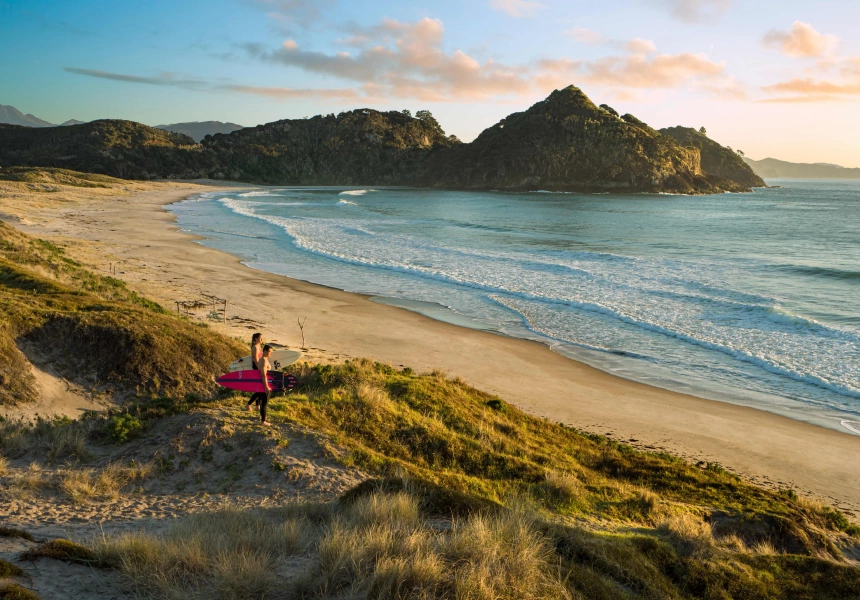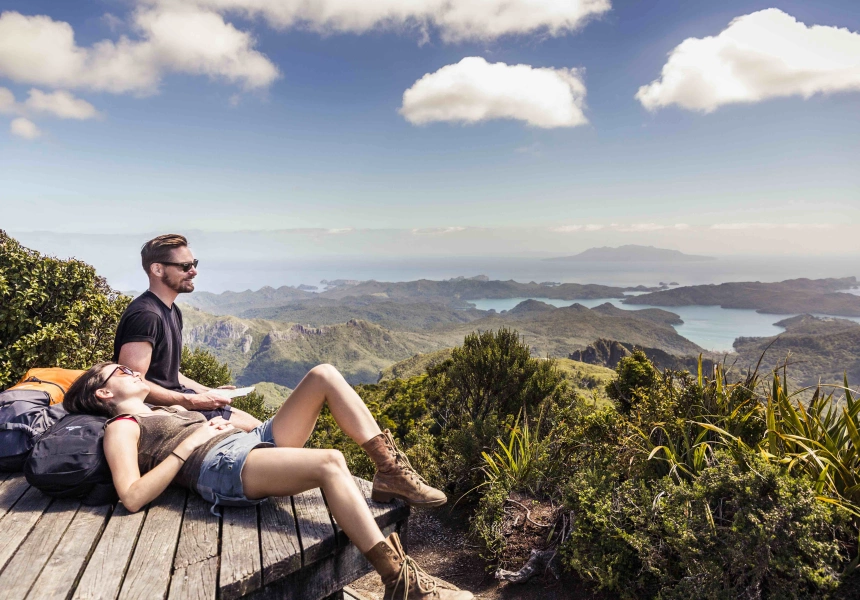New Zealand’s North Island is a land of geographical contrasts, stretching from the warm, sub-tropical north to the windswept Cook Strait near Wellington in the south. But dotted around its shores and within its lakes and harbours are hundreds of smaller islands, each with a different story to tell.
The Bay of Islands in the far north lives up to its name, with countless water-bound getaways on which to anchor a chartered yacht. Many other islands, meanwhile, serve a conservation purpose, being predator-free havens for endangered birds and reptiles. Others still – such as Waiheke Island – offer up boutique wineries, stunning beaches and adventure tourism.
Best of all, every island is close enough to be accessible for day trips or weekends away. Here are six to check out.
Never miss a moment. Make sure you're subscribed to our newsletter today.
SUBSCRIBE NOWGreat Barrier Island
Known as Aotea to the local Ngati Rehua people, Great Barrier Island is New Zealand’s fourth-largest island (after North Island, South Island and Stewart Island) and easily accessed from Auckland via a fast ferry (4.5 hours) or plane (30 minutes). The island guards the entrance to the Hauraki Gulf, creating a barrier from the rough swells of the Pacific Ocean and aiding a safe passage for boats into Auckland Harbour.
It feels large, too. The sense of open space and wild nature is only emphasised by the sparseness of population. With around 1000 inhabitants, it sometimes feels like you’re the only person here.
Don your backpack for hiking adventures, including the three-day Aotea Track, staying in Department of Conservation (DOC) huts and taking in the island’s highest point, Mount Hobson (627 metres). If you prefer to keep things coastal, hire a car and beach-hop for swimming, surfing or kayaking. The white sand and calm water of Gooseberry Flat Beach is perfect for families, while Awana Beach is the pick for surfers and has a DOC campground. (Editor's note: The Lower Kaiaraara Track is currently closed.)
The night sky becomes a starry dreamscape at Good Heavens, where you can stargaze from the sand dunes to the soundtrack of the sea. Blankets, “moon chairs” and even hot water bottles are provided on chilly nights. With zero light pollution, the venture has been awarded Dark Sky Sanctuary status – it’s just one of three sites in Australasia to receive the honour.
Round out your weekend away with a dip in the natural Kaitoke Hot Springs or seek out wildlife encounters at Glenfern Sanctuary, an 83-hectare, predator-free regional park that protects native birds and lizards.
Waiheke Island
Many Aucklanders still remember the days when Waiheke Island was a haven for kiwis seeking respite from the big city. The locals have slowly made way for investors, with the idyllic island now one of the most sought-after destinations in the country for both holiday-makers and holiday home owners.
Just a 40-minute ferry ride from Auckland’s CBD, Waiheke Island is the smaller but more cosmopolitan cousin to Great Barrier Island, boasting boutique and luxury accommodation, vineyards, art galleries and top food and drink options to complement the stunning scenery.
Take a vineyard tour through New Zealand’s “Island of Wine” and learn about its unique terroir and the techniques that go into producing wines (predominantly red) that woo on the world stage. Waiheke Wine Tours offers a daily tour departing from the ferry wharf at Matiatia at 10.40am and can tailor bespoke packages that might include lunch, a craft beer brewery tour or even a helicopter flight.
Charlie Farleys at Onetangi Beach is a long-standing institution and the go-to spot for a coastal cocktail, tasty pub meals and outdoor live music, and if you need a bit of exercise afterwards, tour the island on an electric bike to take the labour out of those hills.
Kapiti Island
A dominant presence off the Kapiti Coast, just north of Wellington, Kapiti Island is one of the country’s first and most important bird sanctuaries. It took until the late 1990s for rats to finally be eradicated from the island, allowing endangered native birds such as the saddleback and the kokako to thrive. It’s an island off the grid – to preserve the natural environment – and there are no shops, public roads or other infrastructure on the island, so come prepared.
Kapiti Island Nature Tours run daily tours departing from Paraparaumu Beach at 9am and returning around 3pm. Tours include a one-hour guided nature walk, up-close encounters with birds and a cooked lunch (ferry ticket included). You’ll learn about the steps New Zealand is taking to become “predator-free” by 2050 and get an insight into the island’s role in that quest.
If you’d rather go it alone, a return ferry ticket costs AU$120 and includes an introductory talk from a guide. From the wharf walking tracks lead through lush native forest to the island’s highest point, for extensive views back to the mainland and across to the peaks of the nearby Tararua Range. The South Island might also be visible, depending on the weather.
For the full Kapiti Island experience book an overnight kiwi spotting tour and give yourself the best chance to see the nocturnal bird in the wild. Accommodation is at a lodge at Waiorua Bay at the north end of the island and includes a home-cooked meal plus local wine and beer.
Kapiti Island has a long Māori history, being the base of the famous chief Te Rauparaha, leader of the Ngati Toa tribe. Te Rauparaha used the island as a fortress to launch raids by sea on rival tribes and defend against attacks.
Bay of Islands
If New Zealand has a Whitsundays, it’s the Bay of Islands. Close your eyes and think of the setting of your dreams – bush-fringed islands floating in sub-tropical waters, a sprinkle of yachts moored in calm bays, and dolphins leaping across your bow as you cruise to the next port, where good food and drinks in bayside bars await. That’s the Bay of Islands.
Charter a yacht from Russell or Opua and embark on a choose-your-own-adventure, weaving between over 100 islands, many with safe anchorages to pull into come evening. If you’re not confident skippering your own boat, most charter companies – such as Fair Wind Charters – offer a skipper (and even a cook), to accompany you but we reckon the best fun is had with your own group (although some sailing experience does help).
The region is also steeped in history. New Zealand’s founding document, the Treaty of Waitangi, was signed in the town of Waitangi in 1840. Dock your boat long enough to take an interactive tour of the Waitangi Treaty Grounds, witnessing a traditional performance in a marae (meeting house), and taking in two museums and a waka (war canoe) carved from kauri trees – at 37.5 metres long, it’s the largest ceremonial war canoe in the world.
Adventure seekers can try parasailing, while the more leisurely inclined can explore the shops of historic towns such as Russell and Kerikeri.
Matiu-Somes Island
Wellington’s geography is part of what makes the city so special. A ring of hills encircles a harbour, and in the middle of the harbour stands Matui-Somes Island, visible from the city right around to Petone on the north shore and Days Bay in the east.
It’s surprising, then, that the island is often left off many to-do lists when it comes to getting to know New Zealand’s capital city. It’s a tranquil day-tripper’s dream, within easy reach from the CBD.
The island was historically used by various Māori tribes as a strategic fortress. Since then it’s been the site of New Zealand’s first harbour lighthouse, a quarantine station, a base for World War II defences, and now a wildlife sanctuary.
To visit, catch a ferry from Queens Wharf (CBD), Days Bay in Eastbourne, or Seatoun and Petone (weekends only). A walking track takes you round the island, where you can expect to encounter native birds and perhaps even a rare tuatara lizard. There are no shops on the island so bring your own picnic (expect to have your bags checked by a ranger on arrival to make sure you’re not carrying any unwanted stowaways).
It’s a relatively small island, so a couple of hours should cover it. The visitor centre and museum sets out the island’s history (a good first stop), and then it’s over to you to get the lay of the land. Find old gun emplacements, have a swim at the beach, check out the “weta hotels” (small manufactured enclosures for wetas, the distinctive insects native to New Zealand), and climb the highest point for a different perspective of the city you’ve just left behind.
Mokoia Island
Rotorua is known for its exhilarating combination of adventure and culture , and a jet-boat trip to Mokoia Island throws both together. The island is the setting for one of New Zealand’s most famous love stories, the legend of Hinemoa and Tutanekai. Separated by the waters of Lake Rotorua, Tutanekai played his flute from his home on Mokoia Island to signal his beloved Tutanekai to swim across the lake and into his arms. The tale spurned the beautiful song Pōkarekare Ana and continues to make every trip to the sacred Mokoia Island an emotionally affecting experience – a chance to step into legend.
While Tutanekai had to swim to the island, Katoa Lake Rotorua gets you there significantly quicker. The Speed and Spins with Mokoia Island plus Polynesian Spa tour sees you leaving on a jet boat for an exhilarating 30-minute ride across the lake, followed by a guided tour of the island.
Geothermal hot pools are the soul of Rotorua, and there’s something mystical about the way the steam rises from Hinemoa’s Pool on the island. Mokoia Island is also an important wildlife sanctuary and supports many endangered birds, including the kiwi – expect to hear a chorus of birdsong as you wander the gentle walking tracks.
The jet boat trip back stops at the Polynesian Spa, where you can soak in the mineral hot springs. And if you’re wondering about the “spins” part of the package, our only advice is to hold on tight.
This article is produced by Broadsheet in partnership with 100% Pure New Zealand.
This article was originally published on February 28, 2022 and has since been updated.




